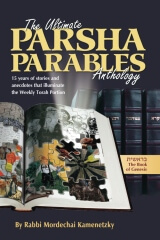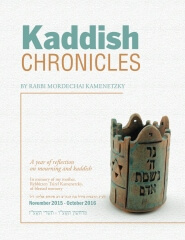
In the final Torah portion that details the completion of the Mishkan, an expression that describes the accomplishment is repeated over and over. In fact, the descriptive assertion is repeated no less than eighteen times!
After the Torah details the completion of each utensil, component, or vestment necessary to finish the Mishkan and begin the service, the Torah uses an expression that declares that they were made “exactly as Hashem commanded Moshe.”
Again and again the Torah repeats the expression almost verbatim. First, the Torah uses the expression in a general sense when telling us how the vestments were made: “exactly as Hashem commanded Moshe.” Then it is used again when detailing each garment. The Ephod and its garters, “were made exactly as Hashem commanded Moshe;” the Choshen and its stone setting were made “exactly as Hashem commanded Moshe.”
The same applies to the vessels of the Mishkan. In addition to a general statement that everything was crafted “exactly as Hashem commanded Moshe,” the Torah reiterates the expression of perfect conformity in regard to each of the utensils. This goes on for almost every component of the Mishkan!
Why? Would it not have been enough to begin or end the summary with one proclamation that everything was crafted “exactly as Hashem commanded Moshe”? Why restate it so often?
Rabbi Zev Wilenski, shli”ta, recited that a student of Rabbi Boruch Ber Lebowitz, z”l, had undertaken to transcribe the notes of the revered sage to prepare them for print. This work would eventually be known as the Birkas Shmuel, one of the classic exegetical works on Talmudic Law.
As the student reviewed the work, he noticed a seeming redundancy of the titles mentioned about Rabbi Yitzchok Zev Soleveitchik, the Brisker Rav who was a son of Rabbi Lebowitz’s own teacher Rabbi Chaim Soleveitchik, and revered as well, by Rabbi Lebowitz.
Each time that Rabbi Lebowitz quoted him, he would preface Rabbi Soleveitchik’s name with all due titles and accolades, “the true Gaon, Rebbe and Teacher of all of Israel, The Gaon of Brisk, he should live to see long and good days.”
Even three or four times in one paragraph, Rabbi Lebowitz would repeat the words, each preceded with a slew of praise and reverence, “the true Gaon, Rebbe and Teacher of all of Israel, The Gaon of Brisk, he should live to see long and good days.”
The next time that Rabbi Soleveitchik was quoted in the works, the student, in the interest of brevity, decided to leave out the seemingly supplementary appellations. Instead he wrote, My Rebbe, the great sage, Rabbi Yitzchak Zev Soleveitchik, shlit”a.
Upon reviewing the work, Rabbi Lebowitz was visibly shaken. “Why did you leave off the introductory appellations? “But, Rebbe,” countered Rabbi Lebowitz’s student, “I mentioned them the first time. Must I repeat them every single time?”
Rabbi Lebowitz was dismayed. “Why am I publishing this book?” he asked in true sincerity. “What do I have from it? Honor? Money? Of course not! I wrote this work so that a student will understand how to learn a Rashba (a medieval commentator) or to understand the Rambam.”
He paused. “The same way that I want them to understand the text, I also want them to understand to appreciate the greatness of the Rebbe. I want them to see and understand that Rav Yitzchak Zev is “the true Gaon, Rebbe and Teacher of all of Israel.”
Perhaps the lesson imparted by each and every action of the Mishkan warrants the Torah’s declaration of perfect conformity for a generalized statement does not impact as much as reiteration.
The Torah is mindful that just as we hammer the facts of dimensions and specifications into our minds, just as we ponder the intricacies of the cups and flowers of the Menorah, the forms and staves of the Table of Showbread, the various stones of the Choshen and their placement inside their settings, so too there is one detail we must not miss. And this detail applies with a freshness for every Mishkan-related activity: each was exactly as Hashem commanded Moshe. Good Shabbos ©2000 Rabbi Mordechai Kamenetzky
Dedicated in memory of Rhoda Fuchs ob”m by Feivy Fuchs, Rachel Weiss, Chana Spira and Families Liluy Nishmas Rivka Matil bas Reb Yaakov of blessed memory
If you would like to be on a shiur update list which sends messagesregarding Rabbi Mordechai Kamenetzky’s various lectures in NY City and LongIsland and other locations, please send a blank email [email protected] You will receive bulletins about those classes.
If you want to be on a shiur announcement faxlist, fax request along withyour fax number (dedicated line, please) to 516-569-7954
Copyright © 1998 by Rabbi M. Kamenetzky and Project Genesis, Inc.
If you enjoy the weekly Drasha, now you can receive the best of Drasha in book form!
Purchase Parsha Parables – from the Project Genesis bookstore – Genesis Judaica – at a very special price!
The author is the Dean of theYeshiva of South Shore.
Drasha is the e-mail edition of FaxHomily, a weekly torah facsimile on the weekly portion
which is sponsored by The Henry and Myrtle Hirsch Foundation
Books by Rabbi Mordechai Kamenetzky:
 |
 |


